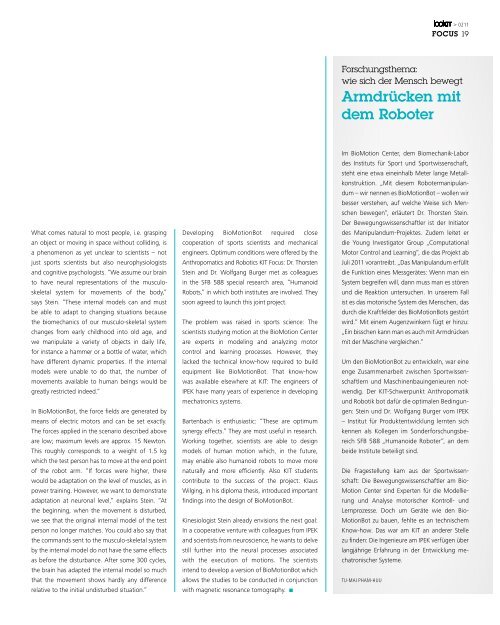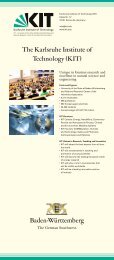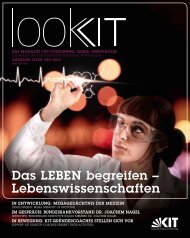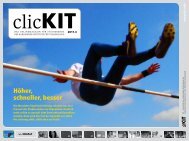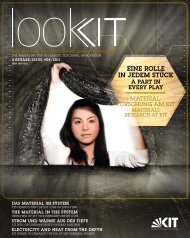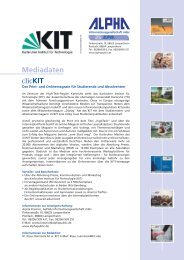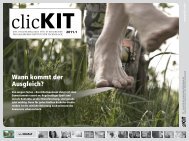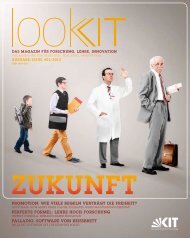lookKIT 02/2011 - PKM - KIT
lookKIT 02/2011 - PKM - KIT
lookKIT 02/2011 - PKM - KIT
Sie wollen auch ein ePaper? Erhöhen Sie die Reichweite Ihrer Titel.
YUMPU macht aus Druck-PDFs automatisch weboptimierte ePaper, die Google liebt.
<strong>02</strong>11<br />
Focus 19<br />
Forschungsthema:<br />
wie sich der Mensch bewegt<br />
Armdrücken mit<br />
dem Roboter<br />
What comes natural to most people, i.e. grasping<br />
an object or moving in space without colliding, is<br />
a phenomenon as yet unclear to scientists – not<br />
just sports scientists but also neurophysiologists<br />
and cognitive psychologists. “We assume our brain<br />
to have neural representations of the musculoskeletal<br />
system for movements of the body,”<br />
says Stein. “These internal models can and must<br />
be able to adapt to changing situations because<br />
the biomechanics of our musculo-skeletal system<br />
changes from early childhood into old age, and<br />
we manipulate a variety of objects in daily life,<br />
for instance a hammer or a bottle of water, which<br />
have different dynamic properties. If the internal<br />
models were unable to do that, the number of<br />
movements available to human beings would be<br />
greatly restricted indeed.”<br />
In BioMotionBot, the force fields are generated by<br />
means of electric motors and can be set exactly.<br />
The forces applied in the scenario described above<br />
are low; maximum levels are approx. 15 Newton.<br />
This roughly corresponds to a weight of 1.5 kg<br />
which the test person has to move at the end point<br />
of the robot arm. “If forces were higher, there<br />
would be adaptation on the level of muscles, as in<br />
power training. However, we want to demonstrate<br />
adaptation at neuronal level,” explains Stein. “At<br />
the beginning, when the movement is disturbed,<br />
we see that the original internal model of the test<br />
person no longer matches. You could also say that<br />
the commands sent to the musculo-skeletal system<br />
by the internal model do not have the same effects<br />
as before the disturbance. After some 300 cycles,<br />
the brain has adapted the internal model so much<br />
that the movement shows hardly any difference<br />
relative to the initial undisturbed situation.”<br />
Developing BioMotionBot required close<br />
cooperation of sports scientists and mechanical<br />
engineers. Optimum conditions were offered by the<br />
Anthropomatics and Robotics <strong>KIT</strong> Focus: Dr. Thorsten<br />
Stein and Dr. Wolfgang Burger met as colleagues<br />
in the SFB 588 special research area, “Humanoid<br />
Robots,” in which both institutes are involved. They<br />
soon agreed to launch this joint project.<br />
The problem was raised in sports science: The<br />
scientists studying motion at the BioMotion Center<br />
are experts in modeling and analyzing motor<br />
control and learning processes. However, they<br />
lacked the technical know-how required to build<br />
equipment like BioMotionBot. That know-how<br />
was available elsewhere at <strong>KIT</strong>: The engineers of<br />
IPEK have many years of experience in developing<br />
mechatronics systems.<br />
Bartenbach is enthusiastic: “These are optimum<br />
synergy effects.” They are most useful in research.<br />
Working together, scientists are able to design<br />
models of human motion which, in the future,<br />
may enable also humanoid robots to move more<br />
naturally and more efficiently. Also <strong>KIT</strong> students<br />
contribute to the success of the project: Klaus<br />
Wilging, in his diploma thesis, introduced important<br />
findings into the design of BioMotionBot.<br />
Kinesiologist Stein already envisions the next goal:<br />
In a cooperative venture with colleagues from IPEK<br />
and scientists from neuroscience, he wants to delve<br />
still further into the neural processes associated<br />
with the execution of motions. The scientists<br />
intend to develop a version of BioMotionBot which<br />
allows the studies to be conducted in conjunction<br />
with magnetic resonance tomography.<br />
Im BioMotion Center, dem Biomechanik-Labor<br />
des Instituts für Sport und Sportwissenschaft,<br />
steht eine etwa eineinhalb Meter lange Metallkonstruktion.<br />
„Mit diesem Robotermanipulandum<br />
– wir nennen es BioMotionBot – wollen wir<br />
besser verstehen, auf welche Weise sich Menschen<br />
bewegen“, erläutert Dr. Thorsten Stein.<br />
Der Bewegungswissenschaftler ist der Initiator<br />
des Manipulandum-Projektes. Zudem leitet er<br />
die Young Investigator Group „Computational<br />
Motor Control and Learning“, die das Projekt ab<br />
Juli <strong>2011</strong> vorantreibt. „Das Manipulandum erfüllt<br />
die Funktion eines Messgerätes: Wenn man ein<br />
System begreifen will, dann muss man es stören<br />
und die Reaktion untersuchen. In unserem Fall<br />
ist es das motorische System des Menschen, das<br />
durch die Kraftfelder des BioMotionBots gestört<br />
wird.“ Mit einem Augenzwinkern fügt er hinzu:<br />
„Ein bisschen kann man es auch mit Armdrücken<br />
mit der Maschine vergleichen.“<br />
Um den BioMotionBot zu entwickeln, war eine<br />
enge Zusammenarbeit zwischen Sportwissenschaftlern<br />
und Maschinenbauingenieuren notwendig.<br />
Der <strong>KIT</strong>-Schwerpunkt Anthropomatik<br />
und Robotik bot dafür die optimalen Bedingungen:<br />
Stein und Dr. Wolfgang Burger vom IPEK<br />
– Institut für Produktentwicklung lernten sich<br />
kennen als Kollegen im Sonderforschungsbereich<br />
SFB 588 „Humanoide Roboter“, an dem<br />
beide Institute beteiligt sind.<br />
Die Fragestellung kam aus der Sportwissenschaft:<br />
Die Bewegungswissenschaftler am Bio-<br />
Motion Center sind Experten für die Modellierung<br />
und Analyse motorischer Kontroll- und<br />
Lernprozesse. Doch um Geräte wie den Bio-<br />
MotionBot zu bauen, fehlte es an technischem<br />
Know-how. Das war am <strong>KIT</strong> an anderer Stelle<br />
zu finden: Die Ingenieure am IPEK verfügen über<br />
langjährige Erfahrung in der Entwicklung mechatronischer<br />
Systeme.<br />
Tu-Mai Pham-Huu


